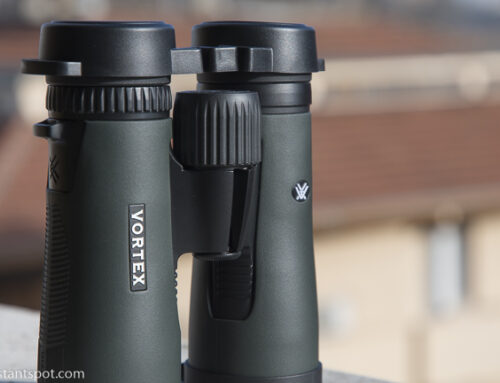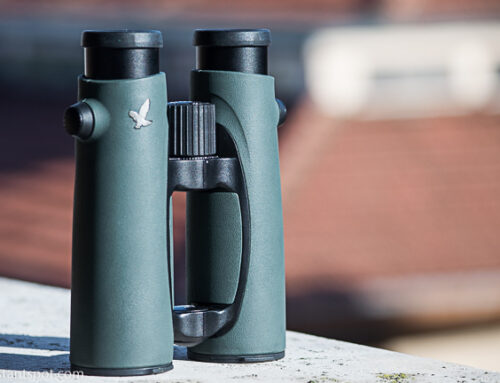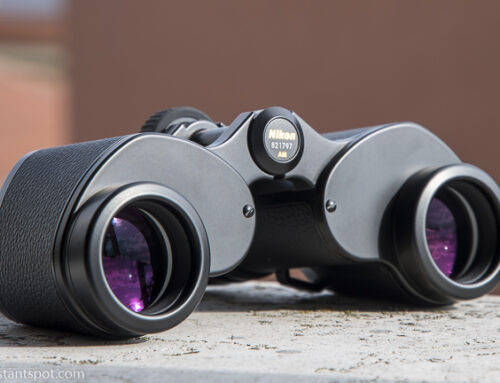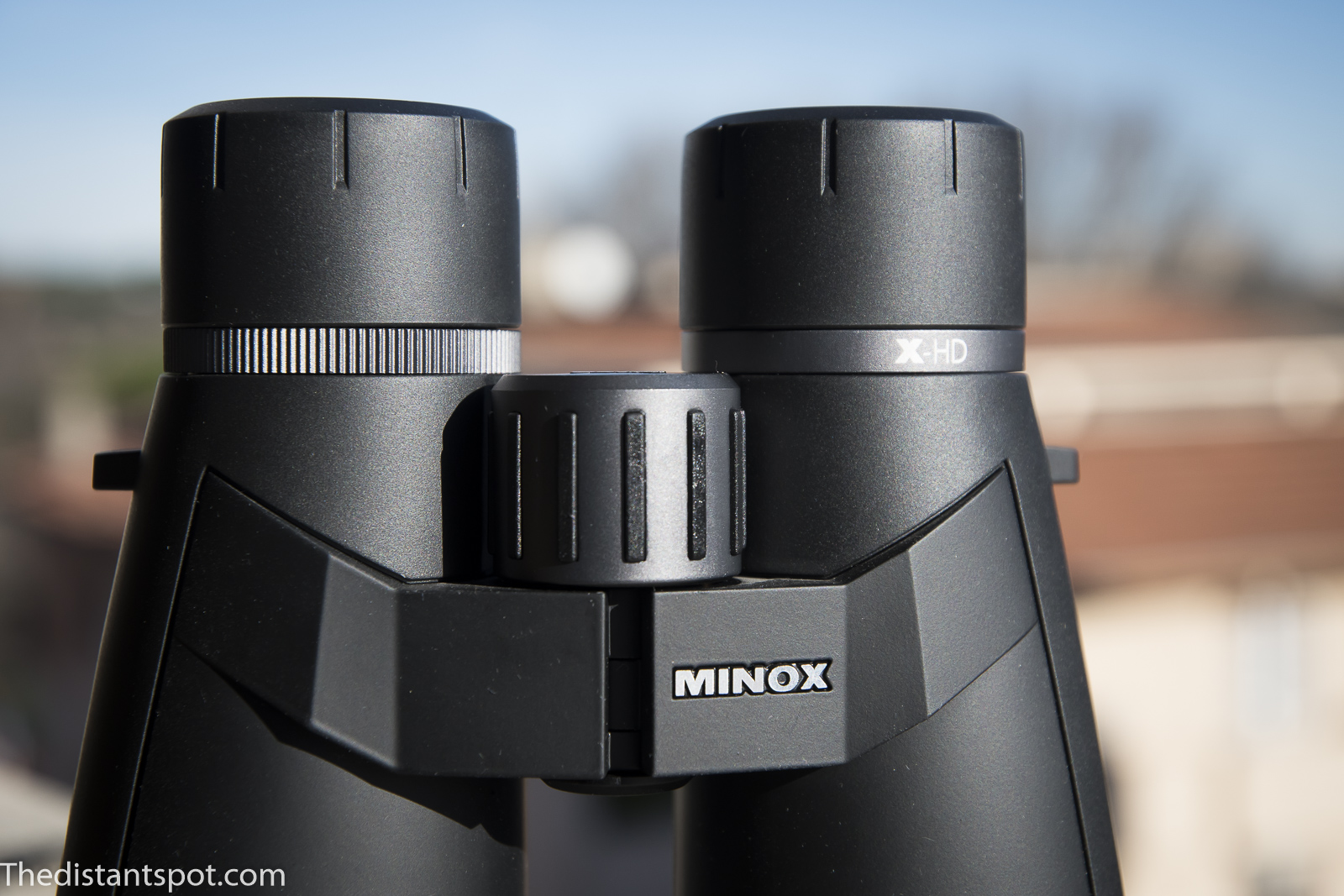Minox X-HD 8×56
Introduction
I really appreciate that Minox has decided to make an 8×56 model within their best product line. More and more often I see producers focusing on the classic 8×42 and 10×42 models, neglecting the other formats. Sometimes – and often at a later stage – an 8×32 is also produced, but it is increasingly rare to find 8×56 binoculars among the top of the range. For example, none of the top three European brands has a recently released 8×56 binoculars in its catalogue.
With its appreciable decision, therefore, Minox has filled a void, offering one more choice to those interested in this kind of instrument.
I don’t have other binoculars with a 56mm aperture, so I will compare the Minox X-HD 8×56 with the Swarovski EL 8.5×42 W B and with the Nikon 8×30 EII. Obviously, their first competitor would be the Steiner Nighthunter 8×56, but since I can’t make a direct comparison with them, I’ll have to limit myself to reviewing what I had the opportunity to note when I had the chance to try them out.
Construction
When your binoculars weight 1250 grams, ergonomics is a crucial factor. The Minox X-HD 8×56, although inevitably cumbersome due to their large lenses, maintain small dimensions thanks to the use of roof prisms. This makes them much more comfortable to use than the Steiner Nighthunter 8×56 which, despite having a comfortable grip, were so large as to force the user to keep his arms spread apart in a way that was tiring after just a few minutes.
In the case of the Minox X-HD 8×56, what can become tiring, if anything, is the fact that most of the weight is concentrated in the front lenses, therefore, to improve the overall balance, it is essential to hold the binoculars with your hands far enough away from your face.
The binoculars sports a black rubber covering that feels slightly sticky to the touch, which is not entirely pleasant and attracts small specks of dust that are impossible to get rid of (just look at the photo below to get an idea). Moreover, in our specimen, the rubber covering was slightly damaged on two edges.
The black color means the Minox will get hot in the sun. This is quite noticeable during winter, but it is not a problem: I wonder how it could be during summer. At least now I understand why the other brands often use a dark green rubber.
One of the two eyecups was a little loose, leading to some doubts about its durability over time.
Furthermore, for the first time ever, I had difficulty inserting my nose between the eyepieces due to the size of the shells and, although this did not prevent the use of the binoculars, I still found it quite annoying.
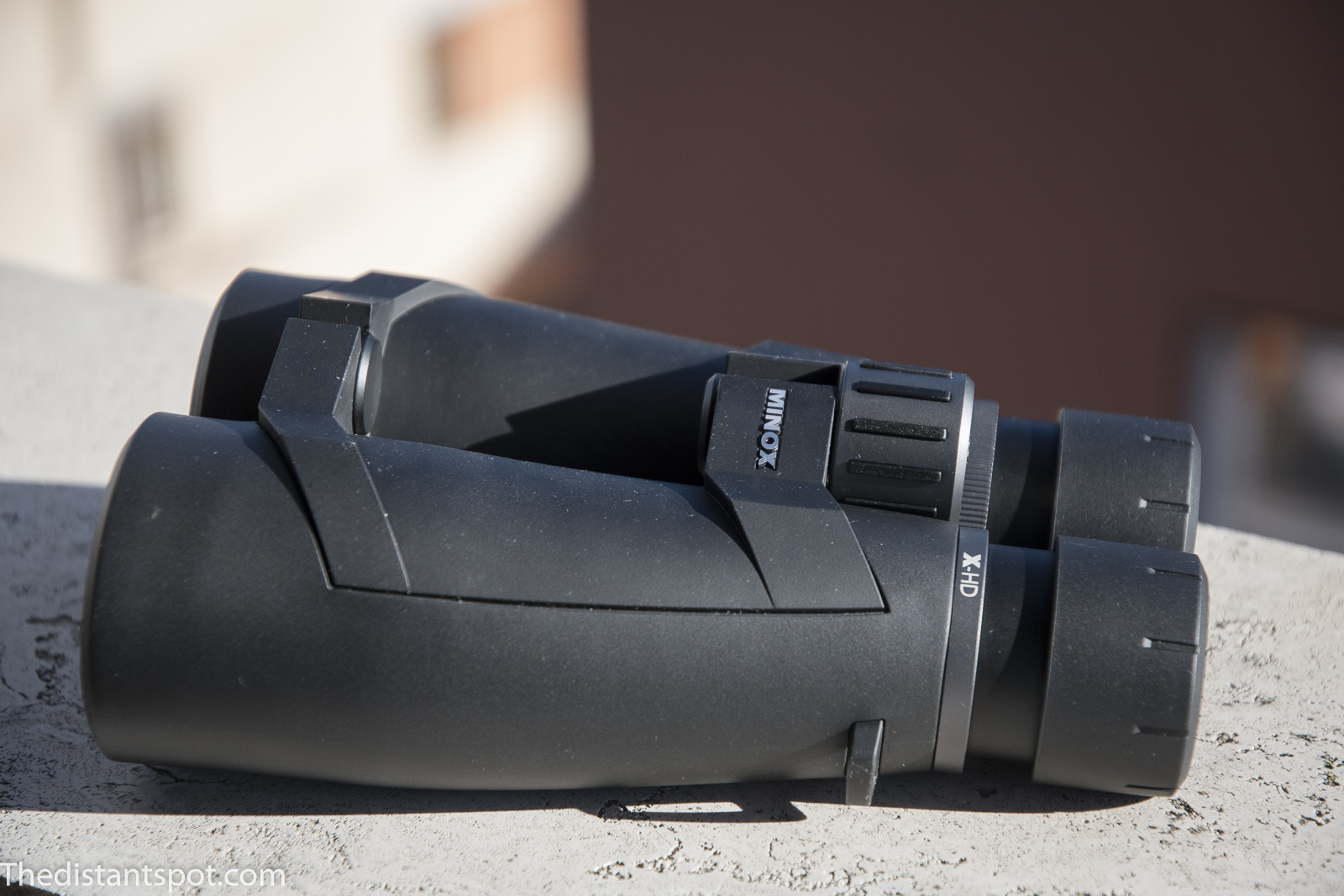
Optical qualities
The Minox X-HD 8×56 offer decent performance, even good under certain specific points of view and yet, considering their price, I have to say that I would have expected more.
Although they are very pleasant from an aesthetic point of view, with a mix of black and silver that makes them look modern, they are neither sharp enough nor correct enough to justify their price of a thousand euros.
Furthermore, the field of view is not particularly wide and is certainly inferior both to that of the Nikon 8×30 EII – which, however, are highly appreciated precisely for the breadth of their field of view – and to that of the Swarovski, which are in any case top of the class, like befits a pair of binoculars in their price range. It seems to me rather similar to that of the Kowa BD 8×32 Prominar XD: slightly wider if you accept to look with the shells not fully extracted; narrower if they are completely extracted (but that will lead to easier blackouts – read below).
Chromatic aberration
The Minox X-HD 8×56 correct chromatic aberration well. Even in strong light conditions, this defect is not particularly visible or annoying, becoming evident only at the edge of the field of view. As is often the case when it comes to chromatic aberration, the Swarovski perform significantly worse. By framing the bare branches of a tree, you get a general impression of violet which immediately disappears when you switch to the Minox (and also to the Nikon, to tell the truth).
At night, however, the situation is a bit different: framing a luminous sign, the Minox X-HD 8×56 exhibit a chromatic aberration not unlike that of the Swarovski, even in the exact center of the image. Unlike their more expensive competitor, however, they manage to keep it at a very acceptable level all the way to the edge of the picture.
However, the Kowa are the most correct of the group: invisible aberration in the center and almost absent at the edges.
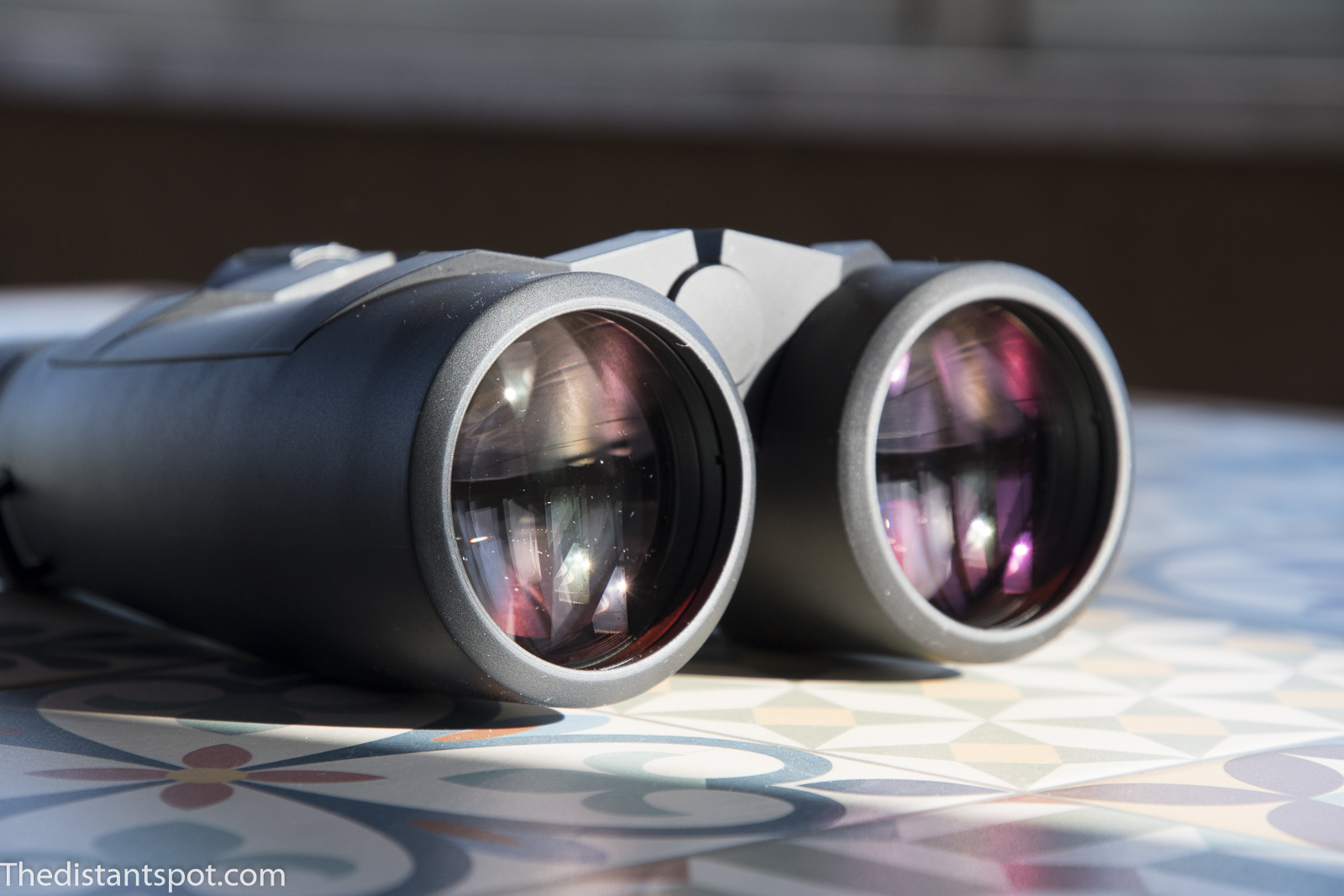
Sharpness
I have no doubt that the binoculars are sharper than the Minox 8×33 which I had the opportunity to try a few years ago and which couldn’t claim to have “HD” lenses. Still, the update has not led to a revolution: the overall sharpness is still unsatisfactory and below that of the other binoculars with which I have compared them. This is true in comparison with the Swarovski, which cost considerably more than the Minox, but also with the Nikon, which cost just over a half of the Minox, do not mount ED/HD glass and are the result of a project that dates back to many years ago . In this we can undoubtedly see another confirmation of the goodness of porro prism systems compared to competitors with roof prisms, which are always more expensive or, given the same price, less performing.
A side effect of the insufficient sharpness of the Minox X-HD 8×56 is that is harder to determine the optimal focus, forcing you to play a bit with the ring before being convinced that you have found the best point. Otherwise, with binoculars like the Swarovski EL 8.5×42 W B, the focus is precise and clear and the image immediately catches the eye as the “right” one.
The field curvature becomes quite important starting from about the middle of the field of view, considerably reducing the overall sharpness. The truly usable field of view is therefore quite small.
Astigmatism
Unfortunately, the binoculars suffer from a fair amount of astigmatism, so that even in the exact center of the image, the stars are still swollen and not punctiform.
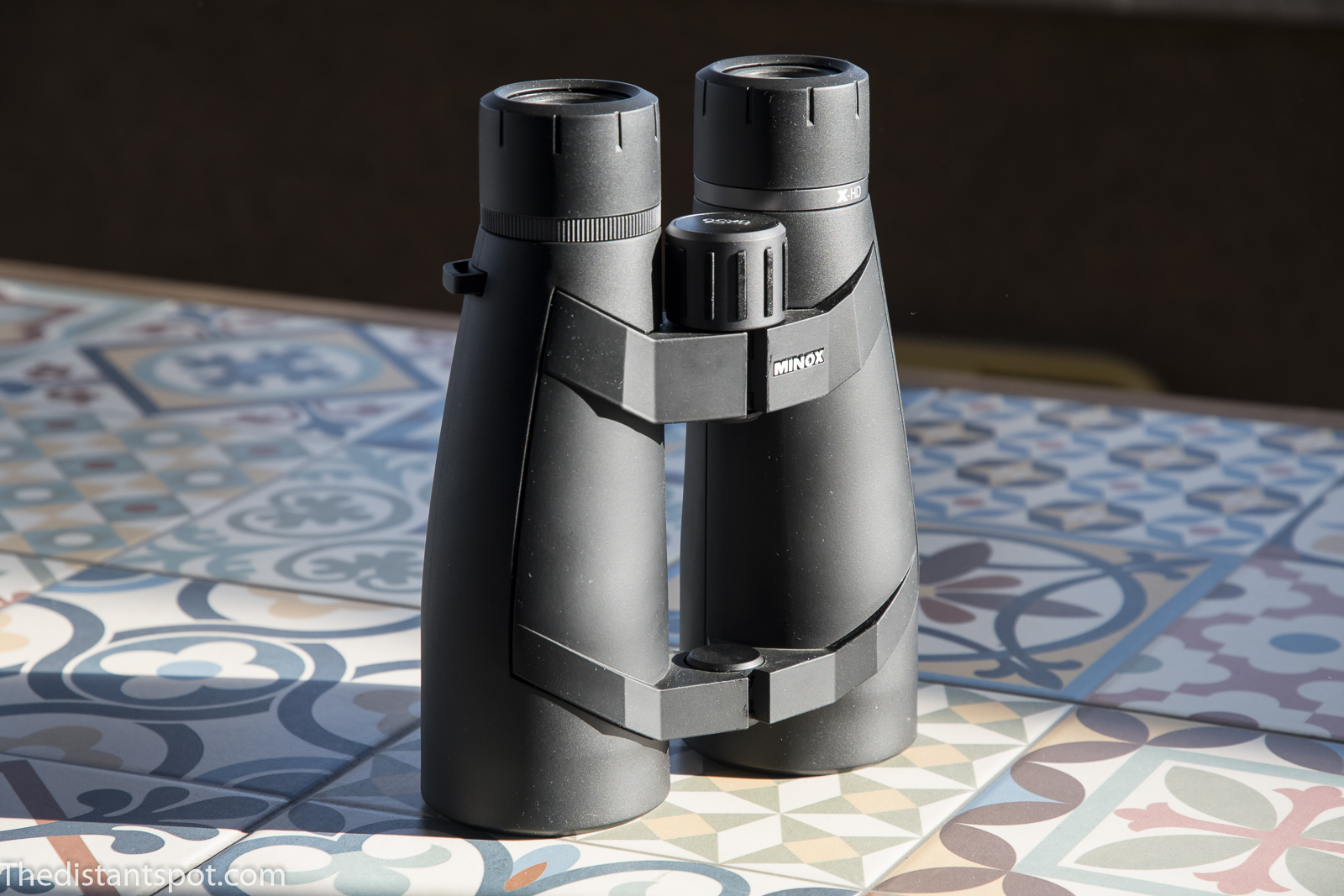
Coma
The coma, together with the curvature of the field, becomes visible from about the middle of the field of view, and is quite severe at the edge of the image.
Both the Kowa BD 8×32 and the Swarovski perform better, being much more correct. In the Kowa, in particular, the deterioration of the image at the edge depends almost exclusively on the curvature of the field, so that it can be compensated for simply by adjusting the focus. The same operation, however, is not decisive in the Minox.
Tint
Unlike the Minox 8×33, which returned an almost yellow image, the 8×56 seem to tend towards cold tones, resulting in any case much more balanced and, I would say, substantially correct.
Reflections and stray lights
Observing street lamps and illuminated signs at night I have to admit that the Minox do an excellent job. It is evident that the manufacturer has devoted much attention to this aspect, as it should be in the case of twilight binoculars. I don’t see particular reflections even when the light source is just outside the field of view and the street lamps produce exceptionally small and barely annoying spikes (unavoidable with roof prisms). Those of the Kowa BD 8×32 are similar, but testing them with an illuminated sign, the Kowa show a small reflection on the opposite side of the field of view which is instead absent in the Minox.
As I had the opportunity to point out in our review, even the Swarovski offers lower performance from this point of view.
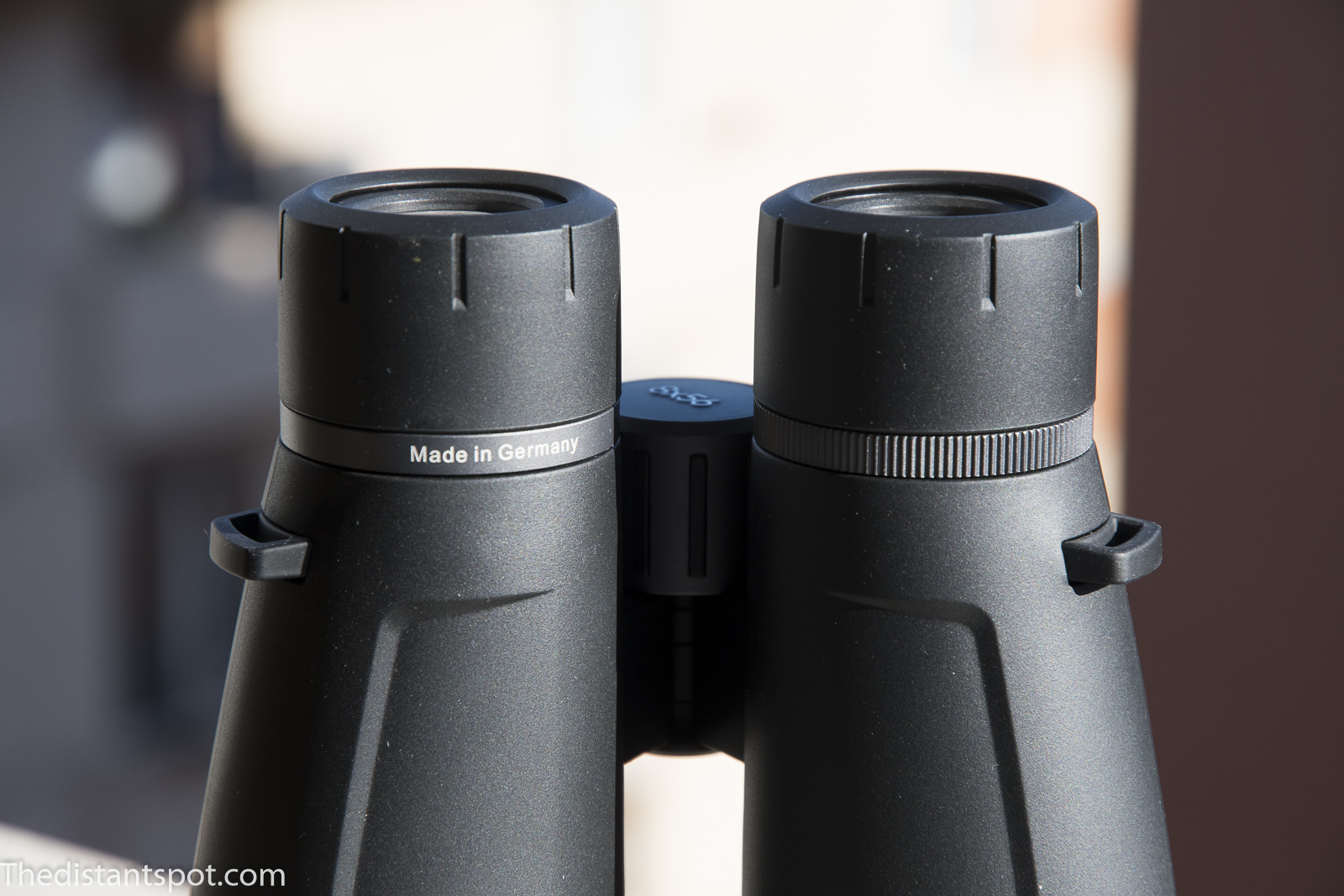
Distortion
There is quite noticeable barrel distortion, whereby vertical lines at the edges of the image tend to bend towards the centre. Not particularly annoying.
Other aspects
With the eyecups fully pulled out, you cannot view the entire field of view.
As a result, the field stop isn’t as sharp as I would like it to be (and as the photo below might lead you to think!), but there is some haziness near the edge of the frame.
Unlike what I experienced with the Vortex Diamondback, however, I was able to turn the shells down one click without causing unbearable blackouts (although it still made them more frequent).
Finally, the image is not particularly contrasted: the Nikon 8×30 EII are much more performing from this point of view.
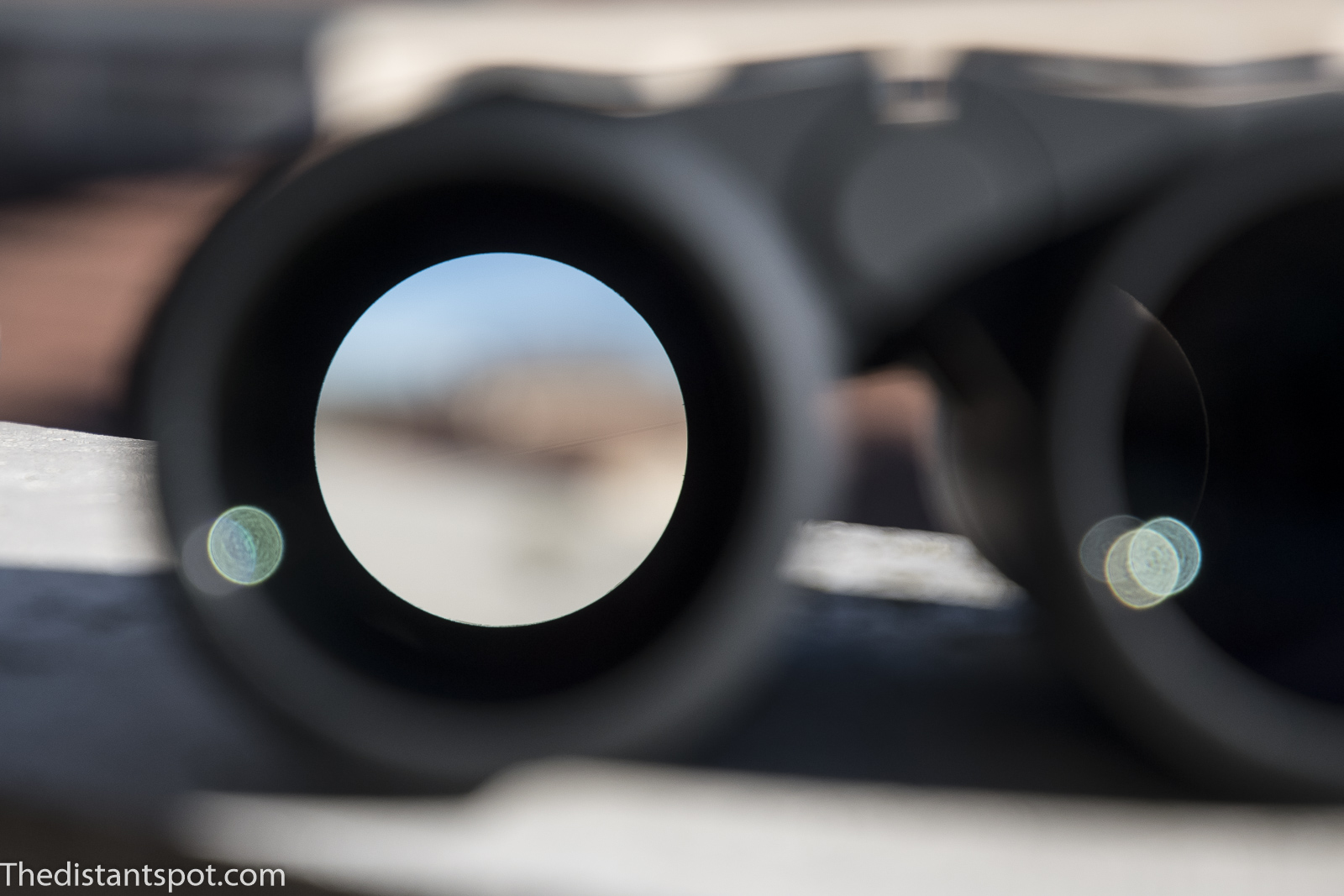
Conclusions
Unfortunately I have to note that, even with a higher cost, the Minox X-HD 8×56 “Made in Germany” do not reach the quality level of the Steiner 8×56, even if the adoption of roof prisms made them more comfortable to use.
Curiously enough, the Steiner had similar problems visualizing the entire field of view.
Compared to the very good Minox 8×33 that I tried a few years ago, it seems to me that an opportunity has been lost and, although some defects have been fixed (like the tint, which is no longer tending towards yellow), others have remained unchanged (the poor sharpness) or have even worsened (the comfort of observation and the blackouts).
The Minox X-HD 8×56 are good, but probably too expensive for the performance they offer. A thousand euros is a respectable figure, which should grant a ticket for the higher end of the market: in this case, however, despite having quite some strengths, the binoculars do not seem to belong to that category.
Minox X-HD 8×56
Introduction
I really appreciate that Minox has decided to make an 8×56 model within their best product line. More and more often I see producers focusing on the classic 8×42 and 10×42 models, neglecting the other formats. Sometimes – and often at a later stage – an 8×32 is also produced, but it is increasingly rare to find 8×56 binoculars among the top of the range. For example, none of the top three European brands has a recently released 8×56 binoculars in its catalogue.
With its appreciable decision, therefore, Minox has filled a void, offering one more choice to those interested in this kind of instrument.
I don’t have other binoculars with a 56mm aperture, so I will compare the Minox X-HD 8×56 with the Swarovski EL 8.5×42 W B and with the Nikon 8×30 EII. Obviously, their first competitor would be the Steiner Nighthunter 8×56, but since I can’t make a direct comparison with them, I’ll have to limit myself to reviewing what I had the opportunity to note when I had the chance to try them out.
Construction
When your binoculars weight 1250 grams, ergonomics is a crucial factor. The Minox X-HD 8×56, although inevitably cumbersome due to their large lenses, maintain small dimensions thanks to the use of roof prisms. This makes them much more comfortable to use than the Steiner Nighthunter 8×56 which, despite having a comfortable grip, were so large as to force the user to keep his arms spread apart in a way that was tiring after just a few minutes.
In the case of the Minox X-HD 8×56, what can become tiring, if anything, is the fact that most of the weight is concentrated in the front lenses, therefore, to improve the overall balance, it is essential to hold the binoculars with your hands far enough away from your face.
The binoculars sports a black rubber covering that feels slightly sticky to the touch, which is not entirely pleasant and attracts small specks of dust that are impossible to get rid of (just look at the photo below to get an idea). Moreover, in our specimen, the rubber covering was slightly damaged on two edges.
The black color means the Minox will get hot in the sun. This is quite noticeable during winter, but it is not a problem: I wonder how it could be during summer. At least now I understand why the other brands often use a dark green rubber.
One of the two eyecups was a little loose, leading to some doubts about its durability over time.
Furthermore, for the first time ever, I had difficulty inserting my nose between the eyepieces due to the size of the shells and, although this did not prevent the use of the binoculars, I still found it quite annoying.

Optical qualities
The Minox X-HD 8×56 offer decent performance, even good under certain specific points of view and yet, considering their price, I have to say that I would have expected more.
Although they are very pleasant from an aesthetic point of view, with a mix of black and silver that makes them look modern, they are neither sharp enough nor correct enough to justify their price of a thousand euros.
Furthermore, the field of view is not particularly wide and is certainly inferior both to that of the Nikon 8×30 EII – which, however, are highly appreciated precisely for the breadth of their field of view – and to that of the Swarovski, which are in any case top of the class, like befits a pair of binoculars in their price range. It seems to me rather similar to that of the Kowa BD 8×32 Prominar XD: slightly wider if you accept to look with the shells not fully extracted; narrower if they are completely extracted (but that will lead to easier blackouts – read below).
Chromatic aberration
The Minox X-HD 8×56 correct chromatic aberration well. Even in strong light conditions, this defect is not particularly visible or annoying, becoming evident only at the edge of the field of view. As is often the case when it comes to chromatic aberration, the Swarovski perform significantly worse. By framing the bare branches of a tree, you get a general impression of violet which immediately disappears when you switch to the Minox (and also to the Nikon, to tell the truth).
At night, however, the situation is a bit different: framing a luminous sign, the Minox X-HD 8×56 exhibit a chromatic aberration not unlike that of the Swarovski, even in the exact center of the image. Unlike their more expensive competitor, however, they manage to keep it at a very acceptable level all the way to the edge of the picture.
However, the Kowa are the most correct of the group: invisible aberration in the center and almost absent at the edges.

Sharpness
I have no doubt that the binoculars are sharper than the Minox 8×33 which I had the opportunity to try a few years ago and which couldn’t claim to have “HD” lenses. Still, the update has not led to a revolution: the overall sharpness is still unsatisfactory and below that of the other binoculars with which I have compared them. This is true in comparison with the Swarovski, which cost considerably more than the Minox, but also with the Nikon, which cost just over a half of the Minox, do not mount ED/HD glass and are the result of a project that dates back to many years ago . In this we can undoubtedly see another confirmation of the goodness of porro prism systems compared to competitors with roof prisms, which are always more expensive or, given the same price, less performing.
A side effect of the insufficient sharpness of the Minox X-HD 8×56 is that is harder to determine the optimal focus, forcing you to play a bit with the ring before being convinced that you have found the best point. Otherwise, with binoculars like the Swarovski EL 8.5×42 W B, the focus is precise and clear and the image immediately catches the eye as the “right” one.
The field curvature becomes quite important starting from about the middle of the field of view, considerably reducing the overall sharpness. The truly usable field of view is therefore quite small.
Astigmatism
Unfortunately, the binoculars suffer from a fair amount of astigmatism, so that even in the exact center of the image, the stars are still swollen and not punctiform.

Coma
The coma, together with the curvature of the field, becomes visible from about the middle of the field of view, and is quite severe at the edge of the image.
Both the Kowa BD 8×32 and the Swarovski perform better, being much more correct. In the Kowa, in particular, the deterioration of the image at the edge depends almost exclusively on the curvature of the field, so that it can be compensated for simply by adjusting the focus. The same operation, however, is not decisive in the Minox.
Tint
Unlike the Minox 8×33, which returned an almost yellow image, the 8×56 seem to tend towards cold tones, resulting in any case much more balanced and, I would say, substantially correct.
Reflections and stray lights
Observing street lamps and illuminated signs at night I have to admit that the Minox do an excellent job. It is evident that the manufacturer has devoted much attention to this aspect, as it should be in the case of twilight binoculars. I don’t see particular reflections even when the light source is just outside the field of view and the street lamps produce exceptionally small and barely annoying spikes (unavoidable with roof prisms). Those of the Kowa BD 8×32 are similar, but testing them with an illuminated sign, the Kowa show a small reflection on the opposite side of the field of view which is instead absent in the Minox.
As I had the opportunity to point out in our review, even the Swarovski offers lower performance from this point of view.

Distortion
There is quite noticeable barrel distortion, whereby vertical lines at the edges of the image tend to bend towards the centre. Not particularly annoying.
Other aspects
With the eyecups fully pulled out, you cannot view the entire field of view.
As a result, the field stop isn’t as sharp as I would like it to be (and as the photo below might lead you to think!), but there is some haziness near the edge of the frame.
Unlike what I experienced with the Vortex Diamondback, however, I was able to turn the shells down one click without causing unbearable blackouts (although it still made them more frequent).
Finally, the image is not particularly contrasted: the Nikon 8×30 EII are much more performing from this point of view.

Conclusions
Unfortunately I have to note that, even with a higher cost, the Minox X-HD 8×56 “Made in Germany” do not reach the quality level of the Steiner 8×56, even if the adoption of roof prisms made them more comfortable to use.
Curiously enough, the Steiner had similar problems visualizing the entire field of view.
Compared to the very good Minox 8×33 that I tried a few years ago, it seems to me that an opportunity has been lost and, although some defects have been fixed (like the tint, which is no longer tending towards yellow), others have remained unchanged (the poor sharpness) or have even worsened (the comfort of observation and the blackouts).
The Minox X-HD 8×56 are good, but probably too expensive for the performance they offer. A thousand euros is a respectable figure, which should grant a ticket for the higher end of the market: in this case, however, despite having quite some strengths, the binoculars do not seem to belong to that category.


